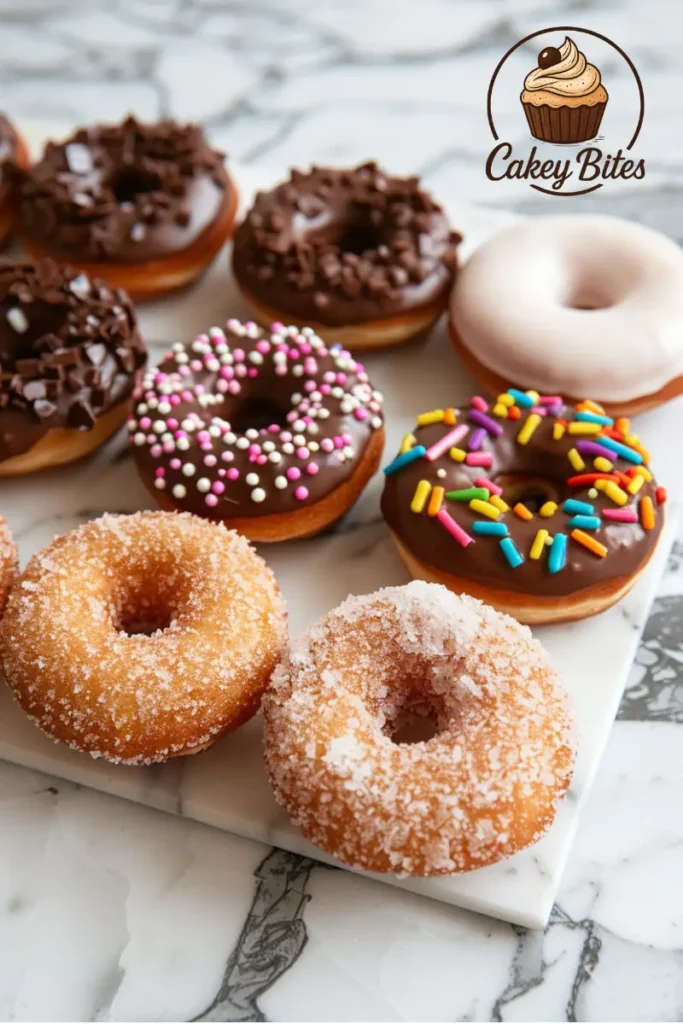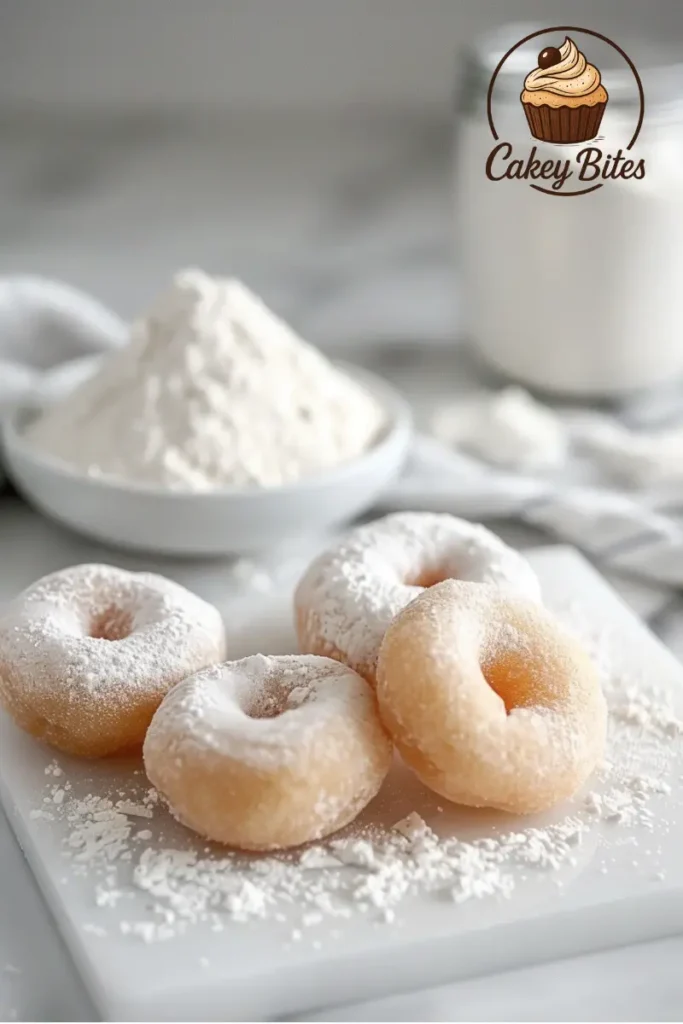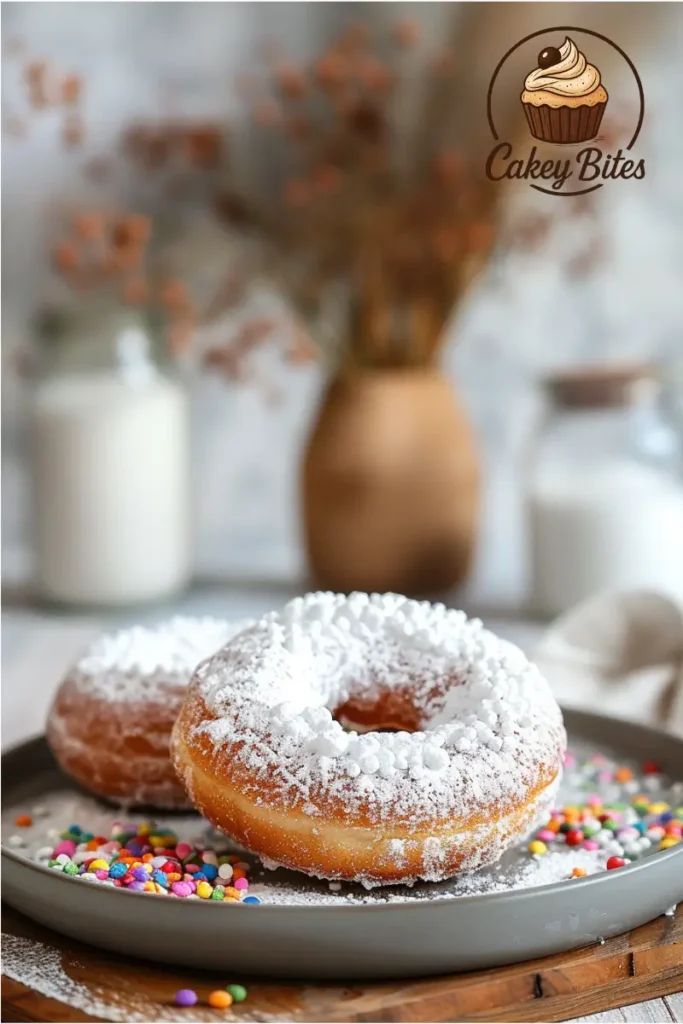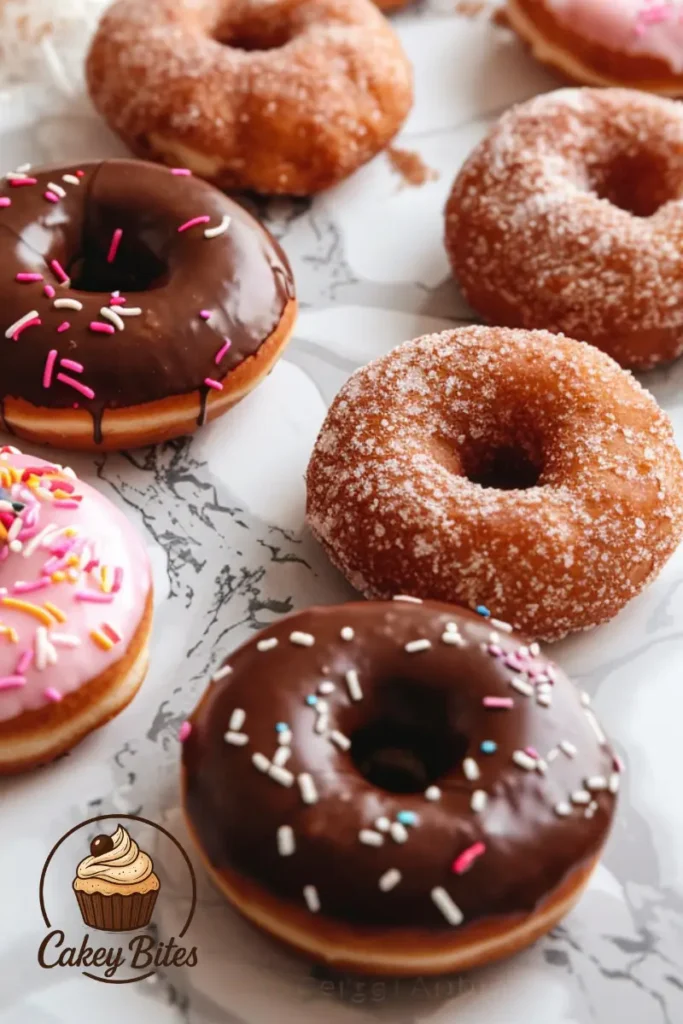JUMP TO
Are Mochi Donuts Gluten Free? The Origin Story Behind the Trend
Are mochi donuts gluten free is often the first question asked by anyone spotting these chewy, colorful donuts in cafés or scrolling on Instagram.. At first glance, made with sweet rice flour, they look safe. Yet, the truth behind are mochi donuts gluten free is more complex. Depending on the recipe, the kitchen, and even the toppings, mochi donuts can be perfectly safe — or risky for someone avoiding gluten.
What Makes a Mochi Donut Different from Regular Donuts?

Regular donuts usually contain wheat flour, making them off-limits for those avoiding gluten. Mochi donuts, however, are often made from glutinous rice flour. This creates a stretchy, chewy texture and removes the need for gluten-based flour — at least in theory.
So, are mochi donuts gluten free simply because they use rice flour? Unfortunately not. Many bakers blend wheat flour into the dough to change the texture, and that small change makes them unsafe for anyone with celiac disease or strong gluten sensitivity.
The Japanese Roots of Mochi: From Rice Cakes to Modern Sweets
Mochi has deep roots in Japanese culture. It’s made from steamed and pounded sticky rice and is naturally gluten free. The mochi donut is a creative twist on this tradition — a fusion of Japanese ingredients and Western presentation.
Today, mochi donuts are served in trendy cafés around the world, with toppings ranging from matcha to cookies and cream. But again, are mochi donuts gluten free in these cafés? The answer depends on recipes, toppings, and how carefully they’re made.
How Mochi Donuts Made Their Way to Western Bakeries
These donuts first appeared in Hawaii and quickly spread to places like California and New York. Their popularity grew thanks to their unique texture and photogenic appearance.
But popularity doesn’t always come with safety. Some shops add wheat flour for stability or use shared fryers. If you love careful dessert crafting, recipes like our mulberry jam show how ingredient transparency makes all the difference. The same logic applies to mochi donuts.
Breaking Down the Chewy Texture: Sweet Rice Flour Explained
The heart of every mochi donut is sweet rice flour, also known as mochiko. And here comes the confusion: “glutinous” sounds like gluten, but it’s not. It simply means sticky. In fact, mochiko is naturally gluten free and gives mochi donuts their famous chewy bite. Still, are mochi donuts gluten free in every shop? Sadly, no. Many bakers blend mochiko with wheat flour to adjust the texture, which removes the safety for gluten-free eaters.
Print
Are Mochi Donuts Gluten Free? A Friendly Guide to Safe Chewy Treats
Discover the truth behind mochi donuts and gluten. Learn whether mochi donuts are safe, how to spot risks in bakeries, and try a simple gluten-free mochi donut recipe at home.
- Total Time: 25 mins
- Yield: 12 mochi donuts 1x
Ingredients
2 cups certified glutinous rice flour (mochiko)
½ cup tapioca starch
½ cup sugar
2 tsp gluten-free baking powder
2 eggs
¾ cup milk (or dairy-free alternative)
2 Tbsp butter (or plant-based oil)
Instructions
Mix rice flour, tapioca starch, sugar, and baking powder in a bowl.
Warm milk and butter, then let cool.
Add eggs and mix into dry ingredients until smooth.
Rest batter for 10 minutes.
Pipe into donut shapes.
Fry at 350°F (175°C) until golden.
Cool before glazing or adding toppings.
Notes
Use flax egg for vegan version.
Use coconut milk for dairy-free option.
Avoid shared fryers if highly sensitive.
- Prep Time: 15 mins
- Cook Time: 10 mins
- Category: Dessert
- Method: Frying
- Cuisine: Japanese Fusion
- Diet: Gluten Free
Nutrition
- Serving Size: 1 donut
- Calories: 160
- Sugar: 8g
- Sodium: 85mg
- Fat: 5g
- Saturated Fat: 2g
- Unsaturated Fat: 2g
- Trans Fat: 0g
- Carbohydrates: 26g
- Fiber: 1 g
- Protein: 3g
- Cholesterol: 25mg
Keywords: are mochi donuts gluten free, gluten free mochi donuts, mochi donut recipe, gluten free desserts
Are Mochi Donuts Gluten Free If Made with Rice Flour?
Even if the flour is gluten free, cross-contamination or additional ingredients can reintroduce gluten. That’s why are mochi donuts gluten free remains a case-by-case issue.
Packaged mixes, bakery shortcuts, and even food colorings can sometimes contain gluten. Choosing to make these donuts at home using clean ingredients — like in our cottage cheese mousse — ensures full control over what goes into your dessert.
Cross-Contamination Risks in Mochi Donut Shops
Here’s where things get tricky:
- Even if the recipe is safe, cross-contamination changes everything. Are mochi donuts gluten free when fried in the same oil as wheat donuts? No — the shared fryer instantly transfers gluten. This risk explains why asking questions like “are mochi donuts gluten free in this bakery?” is essential before buying.
- Toppings like crushed cookies or cereal may contain gluten.
- Surfaces and utensils not cleaned properly can transfer gluten.
This is especially dangerous for people with celiac disease. According to the Celiac Disease Foundation, even tiny amounts of gluten can damage the intestines of those affected. That’s why certified gluten free facilities are the safest choice.
Behind the Counter: How Mochi Donuts Are Made Step by Step
Let’s walk through the process:
- A dough is made using sweet rice flour, sugar, eggs, and starches.
- The dough is shaped into rings or balls.
- It’s fried — sometimes in shared oil.
- Finally, it’s glazed or topped, where gluten can sneak in.
So are mochi donuts gluten free if made with care? Yes — but only if each of these steps avoids cross-contact.
Real Bakery Examples and Their Gluten-Free Policies
Some bakeries do it right: they use 100% rice flour, separate tools, and clean fryers. Others may advertise their donuts as “low gluten” or “gluten-friendly,” which often means they still pose a risk.
As a rule of thumb, if the staff can’t clearly confirm how the donuts are made, it’s best to avoid them. You deserve clarity when asking are mochi donuts gluten free, and only then can you feel safe in your food choices.
Quick Comparison Chart: Mochi Donut vs Regular Donut vs Mochi
| Feature | Mochi Donut | Regular Donut | Traditional Mochi |
|---|---|---|---|
| Main flour | Sweet rice flour | Wheat flour | Sticky rice |
| Gluten content | Possibly gluten free | Contains gluten | Gluten free |
| Cooking method | Fried | Fried or baked | Steamed or pounded |
| Texture | Chewy, stretchy | Soft, fluffy | Sticky, dense |
| Common toppings | Glazes, sprinkles | Glazes, fillings | Soy flour, sweet paste |
| Cross-contamination risk | Medium to High | High | Low |
Gluten-Free or Not? How to Know What’s Really in Your Mochi Donut
Are mochi donuts gluten free is a question many ask. This article helps you learn what matters, what brands offer safe options, and how to avoid gluten risks. You will learn to read labels, ask the right questions, and find trusted brands.
Reading Ingredient Labels: What to Watch For
When you want to decide if mochi donuts are gluten free, ingredient labels are your first tool. Labels speak truth. They show what flours, binders, and fillers are used. Below are some key points to check:
- Look for gluten-containing grains like wheat, barley, rye, and triticale.
- Seek terms like “wheat flour”, “enriched flour”, “bran”, “gluten”.
- Some words hide gluten, e.g. “malt” (from barley), “semolina”.
- Also watch for cross-contamination warnings: “may contain wheat”, “processed in facility that also handles wheat”.
- A gluten-free logo can guide you, but it’s not always enough. Certified gluten-free seals are the most reliable way to know for sure: are mochi donuts gluten free in this package or not. Without certification, the claim that are mochi donuts gluten free is harder to trust.When made at home, mochi donuts can be 100% gluten free. The key is to use certified glutinous rice flour—also called mochiko.
If label says “gluten-free”, you still should check. Certification matters. Some labels are self-declared and loose. Others are regulated by authorities.
Common Flours Used in Mochi Donuts (Rice Flour, Tapioca, Wheat Blends)

Ingredients define whether mochi donuts are gluten free. Mochi donuts get their chewy texture from certain flours. Here are the common ones:
| Flour Type | Gluten Content | Texture Contribution |
|---|---|---|
| Rice flour (sweet or glutinous rice) | None | Soft chewiness, mild flavor |
| Tapioca starch / flour | None | Light springiness, crisp crust |
| Potato starch/sweet potato | None | Tender, slight moisture retention |
| Wheat flour or all-purpose flour | Contains gluten | Adds fluffiness; risks gluten exposure |
| Blended flours (rice + wheat, etc.) | Depends | Could be partially gluten; risky if non-certified |
If a recipe has only rice, tapioca, or other non-gluten flours, then mochi donuts are gluten free. If wheat or blended flour is present, the answer to are mochi donuts gluten free becomes no — they are not safe.
Are Store-Bought Mochi Donuts Gluten Free?
Many store-bought versions are not truly gluten free. They may use wheat flour or be made in shared equipment. To answer the question are mochi donuts gluten free in a store, check carefully for these points:
- Check the ingredients panel for wheat-based terms.
- Look for gluten-free certification (symbols, seals).
- Ask the store: “Does this have wheat, barley, rye?” Also, “Is it made in same fryer or oven as items with gluten?”
- Beware toppings or glazes: some sugar glazes use wheat-based thickener or barley malt syrup.
Interview-Style Section: A Gluten-Sensitive Person Tries 3 Brands
Here’s a brief story. A person with gluten sensitivity tried three brands of mochi donuts. They tested texture, taste, and gluten safety.
| Brand | Taste / Texture | Label Claims | Verdict on are mochi donuts gluten free |
|---|---|---|---|
| Brand A | Very chewy, sweet rice flavor | Says “gluten free”, certified | Safe – mochi donuts are gluten free from this brand |
| Brand B | Slightly dense, crisp exterior | No label; ingredient “wheat flour” | Not safe – mochi donuts are gluten free claim fails here |
| Brand C | Light, crispy, soft inside | “Made in same kitchen as wheat” disclaimer | Risky – are mochi donuts gluten free uncertain |
From this test, only Brand A truly met are mochi donuts gluten free criteria. Brand C showed how cross-contact can spoil safety. It proves that even when gluten isn’t in the recipe, handling matters.
Which Mochi Donut Chains Offer Gluten-Free Options?
Some chains now offer gluten-free mochi donuts or versions.
- Shop X (for example) offers a gluten-free mochi donut option. They use certified rice and tapioca flours. Once asked, they showed their facility is gluten-controlled.
- Chain Y sometimes mixes batches in shared fryers. Their websites often say “not gluten free” or “contains wheat”.
- Local bakeries may offer special orders. If they commit to using separate equipment and pure gluten-free flours, mochi donuts are gluten free there.
Before buying, call ahead and ask directly: are mochi donuts gluten free in your shop? Confirm with staff.
Warning Signs: When a Mochi Donut is NOT Gluten Free
Even when a label seems okay, there are risk signs. They tell you that are mochi donuts gluten free is false for that product:
- The ingredient list includes “wheat”, “flour”, “malt”, “barley”.
- The label lacks gluten-free certification.
- They say “made in facility that also handles wheat”.
- You see signage in the shop saying “contains wheat” or “gluten-containing goods on premises”.
- Toppings or fillings are openly exposed or prepared on shared surfaces.
If any of those appear, the claim that are mochi donuts gluten free is not valid for that item.
How to Ask the Right Questions at Bakeries
Asking helps protect health. Use simple, clear questions. Here are good ones:
- “Is this mochi donut gluten free?”
- “What flours do you use?” (rice? tapioca? wheat?)
- “Do you prepare gluten items near them?” (shared fryer? oven?)
- “Do you have a gluten-free certificate or proof?”
- “Is cross-contamination possible here?”
When you ask, staff will reveal whether are mochi donuts gluten free is true for their product.
Safe Brands & Allergy‑Friendly Bakeries
Below are reliable resources and brands to help you decide if mochi donuts are gluten free in general. Use this info for safety.
- The Celiac Disease Foundation or Celiac.org offers guidance on gluten safety, cross-contact, and risk factors. They help you understand standards. [External resource]
- Some small local bakeries advertise their gluten-free mochi donuts clearly. Check their websites or menus.
If you want a local example, you can also see recipes and tips at CakeyBites home page. They often share mochi donut adaptations. That can guide you when choosing or baking your own.
Summary of Key Takeaways
- Are mochi donuts gluten free depends on ingredients like rice/tapioca flour and absence of wheat.
- Cross-contact is a major risk even if recipe seems clean.
- Certification and clear labeling matter a lot.
- Asking questions and choosing trusted sources or brands keeps you safe.
Homemade Mochi Donuts: The Only Way to Be Sure They’re Gluten Free
are mochi donuts gluten free is a common concern for those avoiding gluten. The safest way to know is to make them yourself. Store-bought versions often use wheat flour or glazes that include hidden gluten. By making them at home, you can fully control the ingredients, preparation, and tools.
Why homemade = safest bet for gluten-sensitive eaters
At home, mochi donuts can truly be 100% gluten free. The secret is to choose certified glutinous rice flour (mochiko). Despite the name, it doesn’t contain gluten. Trusted brands like Koda Farms or Bob’s Red Mill make it easier to bake safe donuts that keep the chewy texture without any risk.
Bakeries, on the other hand, may mix wheat flour into their recipes for texture or structure. Even if the donut base is made from rice flour, glazes and toppings can still contain gluten. Also, shared equipment raises the risk of cross-contact.
According to the Celiac Disease Foundation, gluten can linger in the smallest traces, so home kitchens give peace of mind when thoroughly cleaned and equipped with gluten-free tools.
You might enjoy pairing your freshly made mochi donut with this refreshing sugar-free lemon cake, which also caters to special dietary needs.
Step-by-step: gluten-free mochi donut recipe with rice flour

Here’s a full process to help you confidently make gluten-free mochi donuts at home.
Ingredients
| Ingredient | Quantity | Gluten-Free Notes |
|---|---|---|
| Glutinous rice flour (mochiko) | 2 cups | Must be certified gluten-free |
| Tapioca starch | ½–1 cup | Naturally gluten-free |
| Sugar | ½ cup | Unprocessed sugar is safe |
| Baking powder | 1–2 tsp | Check for “gluten-free” label |
| Eggs | 2 | Naturally gluten-free |
| Milk or non-dairy alternative | ¾ cup | Use unsweetened and gluten-free options |
| Butter or plant-based oil | 2 Tbsp | Safe when pure |
Method
- Combine mochiko, tapioca starch, sugar, and baking powder.
- Warm the milk with butter or oil until just melted, then let cool.
- Stir wet ingredients into the dry until smooth.
- Let batter sit for 10–15 minutes to hydrate.
- Shape using a piping bag or mold.
- Fry in oil at 350°F (175°C) until golden (about 1 minute per side).
- Drain and cool on a wire rack before adding glaze or toppings.
Ingredient swaps: dairy-free, egg-free, vegan options
Making your recipe fit other needs? Here’s how:
- Dairy-free: Substitute coconut milk, oat milk, or almond milk. Use avocado oil or vegan butter.
- Egg-free: Use flax eggs (1 Tbsp flaxseed meal + 2.5 Tbsp water = 1 egg) or aquafaba.
- Vegan: Combine both swaps and use maple syrup or agave instead of sugar.
If you’re looking for a light finish, these date brownie balls make a perfect dessert pairing after a batch of mochi donuts.
Tools you need to make mochi donuts at home
No fancy machines required. These basics will get you started:
- Large and small mixing bowls
- Measuring spoons and cups
- Whisk or rubber spatula
- Piping bag or zip-top bag
- Deep pan or fryer with a thermometer
- Wire rack for draining
Cleaning these tools before use avoids traces of gluten from other recipes.
Where to buy safe gluten-free rice flour online
To avoid contamination, purchase rice flour from reputable sources with clear gluten-free certification.
Trusted online stores include:
- Bob’s Red Mill – They label all gluten-free products clearly and test for safety.
- Celiac Disease Foundation – Offers a Product Directory and Gluten-Free Food Lists to help individuals identify safe, certified gluten-free products.
Avoid generic marketplace brands that don’t list production facility details.
Success stories from readers with gluten intolerance
“I used to think mochi donuts were safe by default. Then I had a reaction after trying one at a café. Since then, I started baking my own and haven’t had any problems.”
“Aquafaba and oat milk made mine both vegan and gluten free. Still chewy and delicious.”
“My daughter has celiac disease. We followed a simple rice flour recipe and she loved the results. It was her first donut in years.”
Troubleshooting: why did my mochi donut turn out gummy?
Gummy texture can be caused by a few things:
- Too much liquid: The batter becomes heavy. Try reducing milk slightly.
- Oil too cold: Donuts absorb oil, stay soggy. Keep oil at 350°F.
- Overmixing: This develops a gluey texture. Mix just until combined.
- Undercooked: Even one extra second in the fryer can make a difference.
Key Takeaways
- The answer to are mochi donuts gluten free depends on the ingredients and how they’re prepared.
- Only use certified gluten-free glutinous rice flour.
- Skip wheat-based glazes or toppings.
- Clean your tools well to prevent contamination.
- Homemade means safer, especially for those with allergies or celiac.
- Use simple swaps to make your recipe fit vegan or dairy-free diets.
- Add a sweet pairing like our sugar-free lemon cake or date brownie balls for a complete treat.
And remember, are mochi donuts gluten free is a valid question—but the only guaranteed answer starts in your own kitchen.
Living Gluten‑Free with Joy: Enjoying Mochi Donuts & Other Chewy Treats Safely
Are mochi donuts gluten free? For many living gluten-free, that question appears each time a soft, chewy mochi donut catches the eye. The great news is that yes, mochi donuts can be safe for gluten-free diets — if you know what to look for.
This guide helps you include them in your routine, understand the risks, and explore other tasty, chewy treats with confidence.
How to include mochi donuts in a gluten‑free lifestyle

When people ask are mochi donuts gluten free, they’re often confused by the term “glutinous.” It refers to the texture — not gluten content. Glutinous rice flour is naturally gluten-free. But that doesn’t mean every mochi donut is safe.
Some recipes mix wheat flour into the batter. Some bakeries cook gluten-free and regular donuts in the same fryer. And even innocent-sounding toppings like cookie crumbles or glazes may include hidden gluten.
Here’s a breakdown of common ingredients:
| Ingredient | Gluten-Free? | Risk Level |
|---|---|---|
| Glutinous rice flour | ✅ Yes | Low – naturally GF |
| Tapioca starch | ✅ Yes | Low – often used for elasticity |
| Wheat flour | ❌ No | High – not safe for GF diets |
| Matcha, fruit powders | ✅ Often | Medium – depends on source |
| Cookie crumbs, glazes | ❓ Varies | High – usually contains gluten unless stated |
A gluten-free mochi donut must be made only with gluten-free flours and ingredients. Even more importantly, it must be prepared in an environment free from cross-contamination. Shared utensils, trays, or oil can instantly make a gluten-free recipe unsafe.
To ensure you’re safe, choose bakeries with clearly labeled options and ask questions. You can also prepare your own mochi donuts at home using certified gluten-free ingredients — like we do with cottage cheese chocolate mousse, which is another easy and gluten-conscious dessert.
Weekly treat planner: managing gluten-free sweets intake
Eating gluten-free doesn’t mean saying no to sweets. It means planning them wisely. Mochi donuts are fun and filling, but they can be high in sugar and calories. That’s why having a weekly plan helps balance your enjoyment.
Here are a few quick tips:
- Limit to 1-2 mochi donut servings per week.
- Stick to flavors you trust and know to be gluten-free.
- Pair your treat with fiber-rich fruits or tea for balance.
- Keep a list of trusted brands or bakeries that offer safe versions.
- Try rotating other treats in, like the indulgent brownie lover’s peanut butter pizza — perfect for a weekend bake.
Mixing in variety helps avoid overload and lets you enjoy different textures and flavors, all while keeping gluten out of the picture.
Traveling tips: where to find GF mochi donuts around the world
Are mochi donuts gluten free everywhere? That depends on where you travel.
In major cities like Tokyo, Seoul, Los Angeles, and Toronto, some cafes now specialize in allergen-free and gluten-conscious baking. Apps like Find Me Gluten Free or HappyCow can help you locate those spots. But there are still risks.
To stay safe:
- Always bring a translated allergy card when traveling internationally.
- Search ahead for cafes with gluten-free certifications.
- Contact bakeries in advance if they don’t advertise allergen info.
- Stick to simple toppings — less risk of hidden gluten.
- Carry snacks from home as backup — like gluten-free mochi or protein bars.
According to the Celiac Disease Foundation, even small traces of gluten can cause serious reactions for those with celiac disease, making planning ahead essential for safety and health.
Gluten-free diet and Asian-inspired desserts: other treats to try
Love mochi donuts? There’s a whole world of Asian-inspired gluten-free desserts you can try next — as long as you read the labels and ask the right questions.
Some safe, chewy treats include:
- Mochi ice cream – just check for wheat in the shell
- Agar jelly with fruit – naturally gluten-free and beautiful
- Tangyuan (sweet rice balls) – gluten-free if made with real rice flour
- Coconut sticky rice with mango – a favorite in Thai cuisine
- Kuzumochi (made from arrowroot) – soft, cool, and free of gluten grains
Home cooks can experiment with these desserts using certified flours. In fact, you’ll find a similar balance of creamy and chewy textures in our homemade cottage cheese fudge bars, another naturally gluten-free favorite that’s simple and family-friendly.
Emotional connection: stories from gluten‑free families
The question are mochi donuts gluten free often becomes emotional when it involves children or loved ones with gluten sensitivity. Parents tell stories of their kids being excluded at birthday parties, or afraid to try anything new at bakeries.
But then something changes. One family shared how making mochi donuts at home became their weekly ritual. They found the right flour, used a safe fryer, and created toppings everyone loved — like cocoa dust or toasted coconut.
Another mother said the first time her daughter took a bite of a safe mochi donut and smiled, she cried — because finally, she didn’t feel left out.
That’s the power of making gluten-free eating joyful. It’s not about restriction. It’s about finding new ways to celebrate.
Final checklist: is your mochi donut safe to eat?
Here’s a simple guide to help you double-check if a mochi donut is really gluten-free:
✅ Uses only glutinous rice flour or other certified gluten-free flours
✅ Clearly labeled gluten-free or made in a safe environment
✅ No wheat, barley, or malt flavorings in glazes or fillings
✅ Prepared with clean tools and separate oil
✅ You’ve confirmed with staff, baker, or label
If all of these are yes, the answer to are mochi donuts gluten free in that case is also a clear yes.
You can also download our free PDF: Gluten-Free Mochi Donut Safety Guide — perfect for keeping in your phone or printing out for your fridge.
Conclusion

So, are mochi donuts gluten free? Yes — but only when made with the right flours, cooked safely, and kept away from cross-contamination. Once you know what to check, you can enjoy mochi donuts with confidence, whether at home or from a trusted bakery. The chewy bite becomes more than a treat — it’s freedom, safety, and joy in every bite.
You’re gaining freedom, flavor, and safety all in one chewy bite. With guides, trusted recipes, and tools like our PDF checklist, you’ve got what you need to live gluten-free with confidence and joy.
🧡
FAQ
Do mochi donuts have gluten in them?
Some do, some don’t. Mochi donuts made only with rice flour are gluten-free. But many bakeries add wheat flour or fry them in shared oil, making them unsafe for strict gluten-free diets.
Does mochi contain gluten?
Traditional mochi is made from sticky rice, which is naturally gluten-free. However, flavored mochi or packaged versions may include gluten-based ingredients.
Are mochi ring donuts gluten-free?
Mochi ring donuts can be gluten-free if made with certified rice flour and cooked in a dedicated fryer. Always ask the bakery for details.
What are mochi donuts made of?
They’re usually made from sweet rice flour (mochiko), sugar, starch, eggs, and milk, then fried and glazed. Some recipes mix in wheat flour.
Does mochi include gluten?
Pure mochi rice does not include gluten. But recipes and toppings may introduce it.
Are your mochi donuts gluten-free?
If homemade with certified flours, yes. But in cafés, it depends on the recipe and preparation method.
Is mochi safe for celiac?
Only if it’s certified gluten-free and prepared in a safe environment with no cross-contact.
Can gluten-free people eat mochi in Japan?
It’s possible, but risky. Many shops don’t separate equipment. Travelers should use allergy cards and look for dedicated gluten-free cafés.
Are macarons gluten-free?
Yes, classic French macarons are made with almond flour, egg whites, and sugar — naturally gluten-free. But check fillings for hidden gluten.

